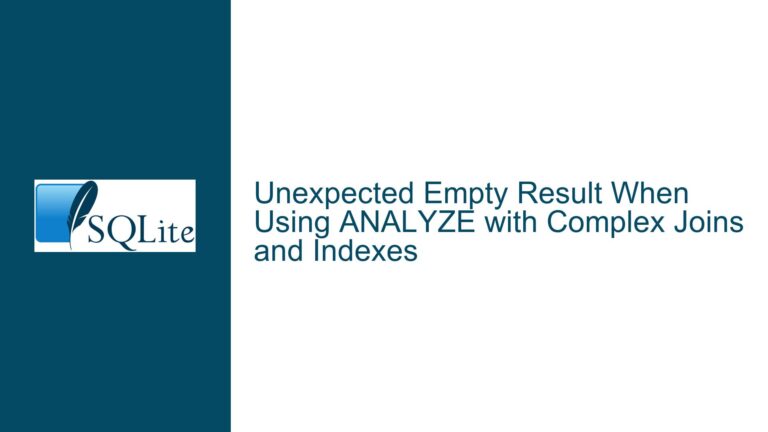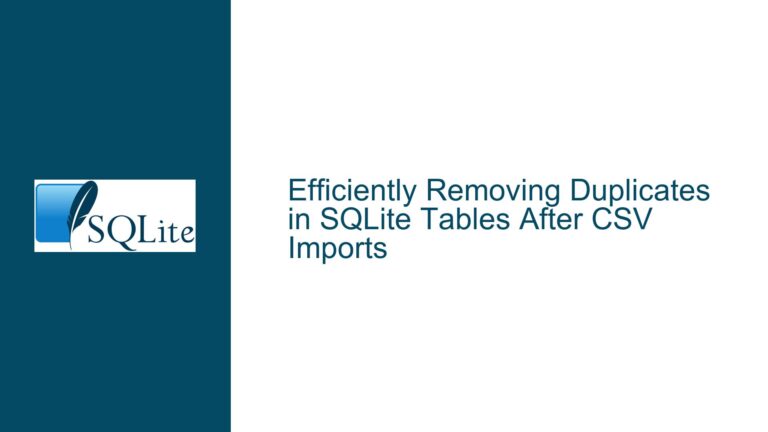Extending sqlite3_vtab_in to Support `column NOT IN (…)` Queries
Understanding the Current Limitations of sqlite3_vtab_in and SQLITE_INDEX_CONSTRAINT_EQ
The sqlite3_vtab_in function is a powerful tool in SQLite’s virtual table interface, designed to handle IN operator constraints efficiently. Specifically, it allows virtual table implementations to process queries involving the column IN (...) syntax by providing access to the right-hand side values of the IN clause. This is achieved through the SQLITE_INDEX_CONSTRAINT_EQ constraint, which is passed to the xBestIndex method of the virtual table implementation. The xBestIndex method is responsible for determining the most efficient way to execute a query, and the SQLITE_INDEX_CONSTRAINT_EQ constraint indicates that the query involves an equality condition on a specific column.
However, the current implementation of sqlite3_vtab_in has a significant limitation: it only supports SQLITE_INDEX_CONSTRAINT_EQ constraints. This means that while queries involving column IN (...) are fully supported, queries involving column NOT IN (...) are not. When a query includes a NOT IN clause, the xBestIndex method does not receive any constraints related to the NOT IN operation. This is because sqlite3_vtab_in does not recognize SQLITE_INDEX_CONSTRAINT_NE (the not-equal constraint) as a valid operator for processing NOT IN clauses.
The absence of SQLITE_INDEX_CONSTRAINT_NE support in sqlite3_vtab_in leads to a gap in functionality for virtual table implementations. Specifically, virtual tables cannot efficiently process queries that involve column NOT IN (...) clauses. This limitation is particularly problematic for use cases where the ability to exclude specific values is crucial, such as in vector search extensions where queries like "find similar vectors to X that aren’t similar to Y" are common.
Exploring the Implications of NOT IN Semantics and Virtual Table Constraints
The NOT IN operator in SQL is used to exclude rows where a column’s value matches any of the specified values in the NOT IN clause. For example, the query SELECT * FROM my_vtab WHERE id NOT IN (1, 2, 3, 4, 5) should return all rows from my_vtab where the id column does not match any of the values 1, 2, 3, 4, or 5. At first glance, one might assume that column NOT IN (1, 2, 3) is semantically equivalent to column != 1 AND column != 2 AND column != 3. However, this assumption does not hold in all cases, particularly when dealing with virtual tables and the sqlite3_vtab_in function.
The primary reason for this discrepancy lies in how SQLite processes constraints for virtual tables. When a query involves a virtual table, SQLite uses the xBestIndex method to determine the most efficient way to execute the query. The xBestIndex method receives a set of constraints that describe the conditions specified in the query. For IN clauses, the SQLITE_INDEX_CONSTRAINT_EQ constraint is used to indicate that the query involves an equality condition on a specific column. However, for NOT IN clauses, there is no corresponding constraint that can be used to indicate a not-equal condition on a specific column.
This lack of a corresponding constraint for NOT IN clauses means that virtual table implementations cannot efficiently process queries involving NOT IN clauses. Instead, they must resort to less efficient methods, such as scanning the entire table and manually excluding rows that match the specified values. This can lead to significant performance degradation, particularly for large datasets or complex queries.
Implementing SQLITE_INDEX_CONSTRAINT_NE Support in sqlite3_vtab_in
To address the limitations of sqlite3_vtab_in and enable support for column NOT IN (...) queries, it is necessary to extend the sqlite3_vtab_in function to recognize SQLITE_INDEX_CONSTRAINT_NE constraints. This would allow virtual table implementations to efficiently process queries involving NOT IN clauses by providing access to the right-hand side values of the NOT IN clause.
The first step in implementing this support is to modify the sqlite3_vtab_in function to recognize SQLITE_INDEX_CONSTRAINT_NE constraints. This would involve updating the function to check for the presence of SQLITE_INDEX_CONSTRAINT_NE constraints in the xBestIndex method and to return true when a NOT IN operation is detected. This would allow virtual table implementations to distinguish between IN and NOT IN clauses and to process them accordingly.
Next, virtual table implementations would need to be updated to handle SQLITE_INDEX_CONSTRAINT_NE constraints. This would involve modifying the xBestIndex method to recognize SQLITE_INDEX_CONSTRAINT_NE constraints and to generate an appropriate query plan for NOT IN clauses. For example, a virtual table implementation might choose to use an index to efficiently exclude rows that match the specified values in the NOT IN clause.
Finally, it would be necessary to update the SQLite documentation to reflect the new support for SQLITE_INDEX_CONSTRAINT_NE constraints in sqlite3_vtab_in. This would include providing examples of how to use the new functionality and explaining the implications for virtual table implementations.
Testing and Validating the New sqlite3_vtab_in Functionality
Once the necessary changes have been made to sqlite3_vtab_in and virtual table implementations, it is important to thoroughly test and validate the new functionality. This would involve creating a series of test cases that cover a range of scenarios, including simple NOT IN queries, complex queries involving multiple NOT IN clauses, and queries that combine IN and NOT IN clauses.
The test cases should be designed to verify that the new functionality works as expected and that it does not introduce any regressions or performance issues. This would involve running the test cases against a variety of virtual table implementations and comparing the results to those obtained using the existing sqlite3_vtab_in functionality.
In addition to functional testing, it is also important to perform performance testing to ensure that the new functionality does not introduce any significant performance overhead. This would involve running a series of benchmarks to compare the performance of queries involving NOT IN clauses before and after the changes to sqlite3_vtab_in.
Conclusion: Enhancing SQLite’s Virtual Table Capabilities with NOT IN Support
The addition of SQLITE_INDEX_CONSTRAINT_NE support to sqlite3_vtab_in would significantly enhance SQLite’s virtual table capabilities by enabling efficient processing of column NOT IN (...) queries. This would allow virtual table implementations to handle a wider range of queries, including those that involve excluding specific values, without resorting to less efficient methods.
By extending sqlite3_vtab_in to recognize SQLITE_INDEX_CONSTRAINT_NE constraints, virtual table implementations can provide more robust and efficient query processing, particularly for use cases such as vector search where the ability to exclude specific values is crucial. This would not only improve the performance of existing virtual table implementations but also open up new possibilities for extending SQLite’s functionality in innovative ways.
In conclusion, the addition of SQLITE_INDEX_CONSTRAINT_NE support to sqlite3_vtab_in is a valuable enhancement that would benefit a wide range of SQLite users and developers. By addressing the current limitations of sqlite3_vtab_in and enabling support for column NOT IN (...) queries, SQLite can continue to evolve as a powerful and versatile database engine.






